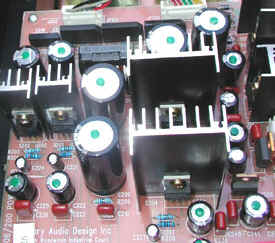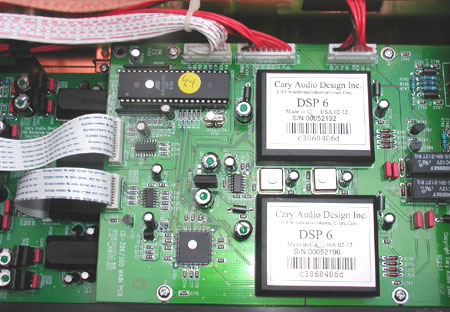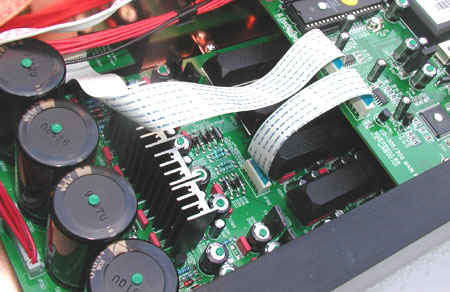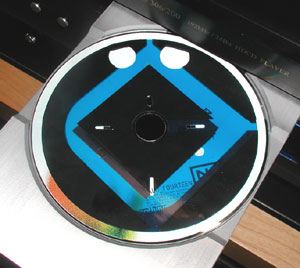You are reading the older HTML site
Positive Feedback ISSUE 2
august/september 2002
Modding the Cary 306/200: More on the Marigo Dots and Shakti On-Lines. Plus the
CDi Blue Statmat from Ringmat.
by Dave Clark
With the recent acquisition of the Cary 306/200 and being the resident tweaker that I am, how could I leave well enough alone? Gee, as good as the Cary is, could it be a bit sweeter and more open? And hey, is that an ever so slight "edge" to the music I hear? Okay, so I am an audio neurotic. There I said it. Happy? So let’s move on to dotting the Cary. Dotting the Cary? Yes, with white and green Marigo Dots, designed to mitigate or "control," to a certain degree, resonances in chips, capacitors, and other circuit parts. See the review in Issue 1: www.positive-feedback.com/Issue1/marigovtsdots.htm or visit the Marigo site: www.marigoaudio.com
Now opening the Cary revealed how well built this player really is and how many parts there are to dot! Must be close to 100 capacitors (Rubycons)—though only about 40 of the size Ron had noted—and about 20 chips with about the same number of power regulators. Holy cow, this is going to be a real pain! After all the dots are only 2-3mm in size and my fingers are not as nimble as they used to be. Fortunately Ron Hedrich sent me more than enough dots to try and instructions on where and which dot to use, so if I lost a few no problem.
Simply put Ron said to do anything flat and black (chips and chip-like devices) with the white dots and any capacitors with the green dots. Ignore the littlest caps, just get the big and medium sized ones. So ever-so-carefully I dotted each chip and each and every capacitor (even had to removed a board so I could get to everything on the analog stage), but I was not able to do the voltage regulators—way too difficult to reach without dropping the dot. Besides, I figured that as hot as the Cary gets, they would not stay put anyhow. Perhaps another time. I will say that I never lost a dot and total time was around an hour—that’s about a dot a minute! Not bad.

Green Dots on capacitors for the power supply

White Dots on the chips, more green dots on capacitors, and
the On-Lines to the left.
The eight Burr Browns are just under the On-Lines. Dotted them too!
Results were rather eye-opening or ear-opening if you prefer. What was a first-class CD player, now offered an even quieter presentation meaning even greater clarity and resolution. Not really any sweeter, but definitely more open. And the "edge"? What edge? No hint of digital edge or glare—just pure clean music. I mean, the music came across as pure as a glass of mountain spring water is after a long hike. I am now hearing music with no listener fatigue after an extended period at rather high-ish levels. This is hard to describe, but the music is just there—no residual noise to get in the way. Talk about resolving power and the ability to hear all the subtleties and nuances on a disc. This is really spooky. But is it more musical? We like to hear the details, but if they rob us of being involved with the music, the answer is, "No." The dots do not make the the player analytical in the sense of being "sterile." Yes, it is more resolving, but in a natural way. I find the music simply even more involving, as I am less "distracted" by artifacts that do not belong within the sonic tapestry. Just pure music.
Any change to the bass? Well, hard to imagine that there was any room for improvement in that area, but I do think it is a bit deeper and more detailed. Perhaps just that faster and cleaner, with a touch more leading edge. And instead of being a bit dry, the player is a smidgen warmer and more dimensional as well. Heck a few dots have turned the Prince into a King!
By the way, we dotted the Sony I talked about in the Cary review in this issue, and low and behold, its bass is a touch deeper with better control too. Still not as good as the Cary, but if you had never heard the two side by side, you would be very happy.
Okay, got the Cary dotted and that definitely made a positive difference so let’s try adding four Shakti On-Lines to the equation (see www.shakti-innovations.com or read my earlier review in Issue 1 at: www.positive-feedback.com/Issue1/shaktistones.htm). Since I only had four, I was limited to placing one above each pair of the DAC chips. I chose these chips as they were the most likely target for the On-Lines. Besides, they were also readily accessible. Using double-back tape I was able to seat the On-Lines on top of some very small capacitors, placing the them directly above the pairs of Burr Brown chips.

More green Dots on capacitors, but this time for the analog
output board. You can see
the four On-Lines just under the top board to the right.
An improvement or just different? Well, things did not sound different in that there was no shift tonally or harmonically with any disc I played. But yes, it was an improvement, as there was still a further drop in the noise floor. This resulting in an even greater degree of clarity and musicality. The music is now a smidgen and half sweeter, and if push came to shove, even more open then before. All with an added increase in dimensional body and air. Cool. Hey, the music also comes across with less artificiality than before to—music sounds just that much more real.
Not bad for two mods that are easily removed.

Alright, let’s try the CDi Blue Statmat from Ringmat Developments (about $50). The CDi Blue is designed to address static electricity that builds up when the disc is spinning in a player. To quote from their literature, "The CDi Blue is a new and far more powerful Statmat for controlling static and other unwanted electronic fields and for correcting signal anomalies. It comprises two Statmats working together at 90� to each other and on different sides of a blue polyester substrate of 0.1mm. The Statmat on top is a mirror image of the standard one below and is connected to the substrate at three equidistant points. The one below is connected at two points." I would recommend going to the Ringmat site to get the full scoop. They have lots of information that explains the why and how. www.ringmat.com
Okay, I live in Log Beach and things never get too dry here. But if the static field is generated by the player, then that is something of a non-issue. On the other hand, if you do live in a very dry place, the added static electricity in the air along with that in a player may be a serious issue.
So in it goes and the music becomes a bit fuller, rounder, meaning there is a bit more "flesh" to the sound than before. More detail? Not really, just a subtle sense of ease or just any residual edge being completely obliterated. Musically it is just that much better. Now in some ways this may not be what one wants, as there is this added quality to the music, meaning it is not as "pure" as it was before. I am not saying the CDi Blue is coloring the music (hey it is blue and the music does have a darker sound to it!), but there is a very subtle shift harmonically. More fullness from the lower midrange and upper bass perhaps. Or am just hearing the music the way it was supposed to be heard—all an issue of controlling the electrostatic fields and such? Heck if I know. What I do know is that I prefer the music with the CDi Blue, which means I have to deal with a mat every time I insert a disc. Darn! I did admit to being an audio neurotic didn't I? Did I say the mat is thin, clear and blue? Well it is, and the thin part means is it somewhat delicate. So buyer beware. It does make a difference, and one that for me at least, is positive.
MANUFACTURER'S RESPONSE
I'm glad you liked it. We are pleased, too. Whilst the improvement is always the same (i.e. constant), the way in which the improvement manifests itself varies from system to system, depending on each system set-up. Of course, the improvement is far more noticeable with the other Ringmat and Statmat products in place. It is all about getting the phase of the signal right and holding it there throughout the system. I am not clear whether the test was done with or without the Marigo Dots and Shakti On-Lines in place. Would be most grateful if you could clarify this point.
Best regards,
John Rogers
Ringmat Development
John,
The mat was used after I dotted and Shakti'd the player. I felt the mat would be the
cherry on top!
Thanks,
Dave Clark
